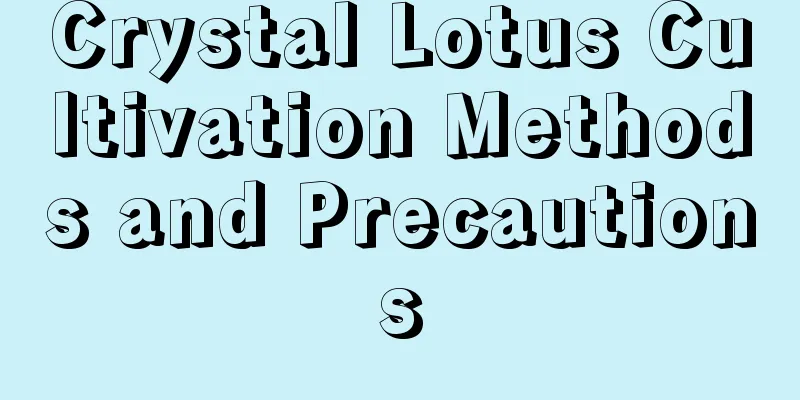Crystal Lotus Cultivation Methods and Precautions

1. Maintenance methods1. Flower pot: Crystal lotus prefers small flower pots. When choosing a flower pot, it is best not to choose a pot that is not breathable or has poor drainage. You can choose some flower pots with good drainage and ventilation, such as ceramic pots and purple clay pots. 2. Soil: It likes a loose and breathable soil environment. You can use sawdust, garden soil and a small amount of leaf mold when preparing it. This kind of soil has good air permeability. 3. Temperature: It grows fastest at 15-25℃, and the maximum temperature cannot be higher than 30℃. In winter, try to move it indoors to keep it warm, otherwise it will freeze to death. 4. Water: During the growing period, the soil needs to be completely dry before watering, and watering must be thorough. In summer, it needs watering every 4 days, and in winter, it needs watering once a week or so. It needs less water during the dormant period and more water during the growing period. 2. Breeding techniques1. Reproduction: The main method of reproduction is division, which can be carried out from April to May. First, peel off the young plants around the mother plant to separate them, and then put them directly into the pot. Place the potted plant in a shaded area and it will take about twenty to twenty-five days for it to take root. 2. Wintering: When maintaining the plant in winter, you should pay attention to keeping warm and avoid maintaining it in temperatures that are too low. Especially in the north, it will be frozen outdoors. 3. Problem diagnosis and treatment1. Anthracnose: Plants are susceptible to anthracnose because the leaves are too dense and there is no good ventilation. Small black spots appear on the stems and nodes and will gradually spread. Once discovered, they should be removed as soon as possible, and then anthrax-free medicine and prevention measures should be used. 2. Rust: It will be infected in a humid and hot environment. The diseased leaves should be cut off immediately, and attention should be paid to ventilation. It should also be sprayed with diniconazole or ammonium chloride. IV. Other issues1. Can it be grown at home: It can be grown at home, but it is recommended to strengthen management and ventilate frequently. 2. Is it edible? The information shows that it is poisonous, so it should not be eaten. |
<<: Cultivation methods and precautions of stone lotus
>>: Cultivation methods and precautions of South American daffodils
Recommend
Is coleus suitable for indoor cultivation?
Can this plant be grown indoors? To answer this q...
What is Cistanche deserticola? Pictures of Cistanche deserticola
1. What is Cistanche deserticola Cistanche desert...
Pineapple planting, when to plant
1. When to plant There are no strict requirements...
Why are the peach leaves turning yellow?
Causes and prevention of yellowing of peach leave...
Eggplant high-yield pruning method
Eggplant has a long growth cycle. If the distribu...
Can orange tree pruning survive? How to plant the cut orange branches?
Can orange tree pruning be transplanted? Orange t...
Cuttings failed, you didn't do these six things right
The secret to successful cuttings 1 Medium requir...
The reason why the scent of pennyroyal is emitted and its function
reason The principle of how catnip emits its frag...
Raspberry cultivation methods and precautions
1. Maintenance methods 1. Soil: Raspberry has str...
Use of nutrient solution for hydroponic flowers
Purchase of nutrient solution Nutrient solution c...
How to fertilize gardenia and what fertilizer to use
1. Fertilization time First of all, when planting...
Cultivation methods and precautions of Nanteng
1. Soil Sandy loam is the preferred soil for grow...
There are yellow spots on the leaves of Milan. Why are the leaves of Milan turning yellow?
1. Strong sunlight exposure Milan is a light-lovi...
What is the best month to plant tomatoes?
As a plant that loves plenty of sunlight, tomatoe...
How to prune lemons
When to prune lemons There is no fixed time limit...









